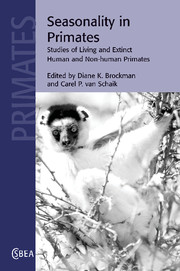Book contents
- Frontmatter
- Contents
- List of contributors
- Preface
- Part I Introduction
- Part II Seasonal habitats
- Part III Seasonality and behavioral ecology
- Part IV Seasonality, reproduction, and social organization
- 10 Seasonality and reproductive function
- 11 Seasonality of primate births in relation to climate
- 12 Energetic responses to food availability in the great apes: implications for hominin evolution
- 13 Human birth seasonality
- 14 Seasonality, social organization, and sexual dimorphism in primates
- Part V Seasonality and community ecology
- Part VI Seasonality and human evolution
- Index
- References
12 - Energetic responses to food availability in the great apes: implications for hominin evolution
Published online by Cambridge University Press: 10 August 2009
- Frontmatter
- Contents
- List of contributors
- Preface
- Part I Introduction
- Part II Seasonal habitats
- Part III Seasonality and behavioral ecology
- Part IV Seasonality, reproduction, and social organization
- 10 Seasonality and reproductive function
- 11 Seasonality of primate births in relation to climate
- 12 Energetic responses to food availability in the great apes: implications for hominin evolution
- 13 Human birth seasonality
- 14 Seasonality, social organization, and sexual dimorphism in primates
- Part V Seasonality and community ecology
- Part VI Seasonality and human evolution
- Index
- References
Summary
Introduction
The past 40 years of great-ape field research have seen the accumulation of a wealth of data that can be used to make predictions about the behavior of early hominins. We have only just begun, however, to undertake great-ape field studies that incorporate a physiological component in the wild. Understanding how the energetic and reproductive systems of living hominoids respond to environmental variation allows us to build more informed models with which to reconstruct the behavior, morphology, and responses to ecological pressures that were present in great-ape and human ancestors.
Fruit is the favored, although not always the most common, food of the great apes, and all ape populations that rely on fruit experience fluctuations in its availability. Given the importance of fruit in ape diets, such fluctuations are likely to have a major impact on these animals' biology and behavior. The primary goal of this chapter is to discuss how differences in overall fruit availability and fallback foods play a central role in shaping energetic and reproductive responses of the great apes, and then to examine the implications of this for hominin evolution.
A review of the literature reveals that relatively few studies present quantitative data on changes in diet or energetics over time. Descriptions are more likely to be statements about how diet or behavior changes in response to fluctuations in food availability.
- Type
- Chapter
- Information
- Seasonality in PrimatesStudies of Living and Extinct Human and Non-Human Primates, pp. 351 - 378Publisher: Cambridge University PressPrint publication year: 2005
References
- 54
- Cited by



